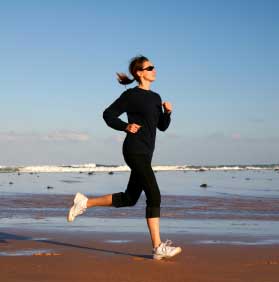 Is running on the beach actually beneficial? Running on the beach has its pros and its cons. Let’s start with the negative first and then move to the positives. The majority of the beaches have a natural slope, thus making it dangerous for the ankles and knees. Sand, although softer than pavement, can cause strains, sprains, or even tendinitis from the inconsistent surfaces and varying pressures, or “give,” from each step. I recommend stretching before and finding a flat surface to run. This will help eliminate most the common injuries stated above.
Is running on the beach actually beneficial? Running on the beach has its pros and its cons. Let’s start with the negative first and then move to the positives. The majority of the beaches have a natural slope, thus making it dangerous for the ankles and knees. Sand, although softer than pavement, can cause strains, sprains, or even tendinitis from the inconsistent surfaces and varying pressures, or “give,” from each step. I recommend stretching before and finding a flat surface to run. This will help eliminate most the common injuries stated above.
Let’s now move on to the positive aspect of beach running. What could honestly be better than running next to the ocean or lake? The beautiful scenery and the sounds of waves crashing the beach, who needs music? Although the sand may increase the risk of fitness injuries like sprains or strains, it also helps to strengthen your ankles, arches, and other muscles. During every step, the sand gives, which makes the body work harder to progress through the movements. Research also shows that beach running requires more energy, thus increasing the heart rate, burning more calories, and developing more power in your legs.
Please take note that beach running is an advanced form of running and you should only try it if your body can handle it. I recommend using the beach as a modification tool. For example, I would switch the style of running each day to help increase your fitness level and keep your body from adapting to a specific style of running.
Day 1: Treadmill
Day 2: Track
Day 3: Street/Sidewalk
Day 4: Grass
Day 5: Hills
Day 6: Beach/Sand
Day 7: Stairs
